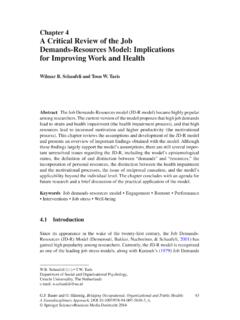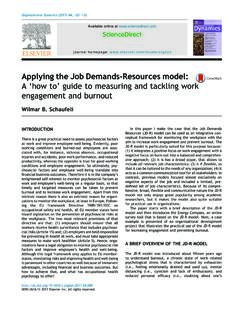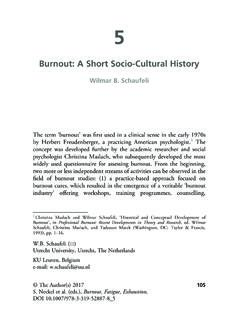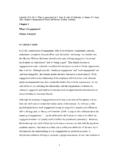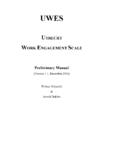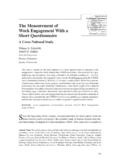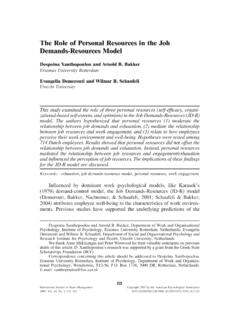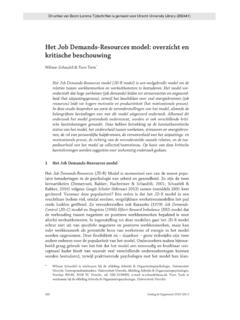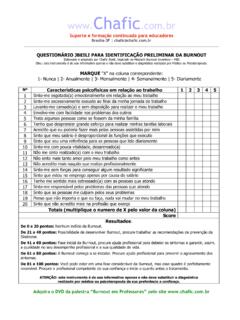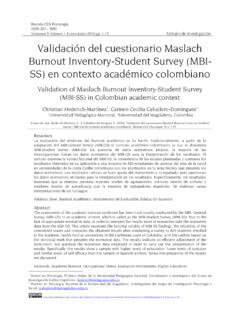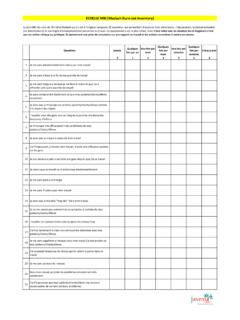Transcription of THE MEASUREMENT OF ENGAGEMENT AND BURNOUT: A …
1 WILMAR B. SCHAUFELI, MARISA SALANOVA,VICENTE GONZ ALEZ-ROM A and ARNOLD B. BAKKERTHE MEASUREMENT OF ENGAGEMENT AND BURNOUT: A TWO SAMPLE CONFIRMATORY FACTORANALYTIC APPROACH(Received 15 December, 2000; Accepted 5 August, 2001)ABSTRACT. This study examines the factorial structure of a new instrument tomeasure ENGAGEMENT , the hypothesized opposite of burnout in a sample of univer-sity students (N=314) and employees (N=619). In addition, the factorial structureof the maslach - burnout inventory -General Survey (MBI-GS) is assessed and the rela-tionship between ENGAGEMENT and burnout is examined. Simultaneous confirmatoryfactor analyses in both samples confirmed the original three-factor structure of theMBI-GS (exhaustion, cynicism, and professional efficacy) as well as the hypothesizedthree-factor structure of ENGAGEMENT (vigor, dedication, and absorption).
2 Contrary toexpectations, a model with two higher-order factors burnout and ENGAGEMENT didnotshow a superior fit to the data. Instead, our analyses revealed an alterna-tive model with two latent factors including: (1) exhaustion and cynicism ( core ofburnout ); (2) all three ENGAGEMENT scales plus efficacy. Both latent factors are neg-atively related and share between 22% and 38% of their variances in both the fact that slightly different versions of the MBI-GS and the engagementquestionnaire had to be used in both samples the results were remarkably similaracross samples, which illustrates the robustness of our WORDS: burnout , ENGAGEMENT , MEASUREMENT , trends recently emerged in burnout research which both boil downto a broadening of the traditional concept and scope ( maslach et al.)
3 ,2001). First, the concept of burnout that was initially closely linkedto the human services such as health care, education, and social workwhere employees do people work of some kind, has been expandedtowards all other professions and occupational groups. Second, burnoutresearch seems to shift towards its opposite: job ENGAGEMENT . Instead oflooking exclusively to the negative pole, researchers recently extendedtheir interest to the positive pole of worker s well-being. Seen fromthis perspective, burnout is rephrased as an erosion of engagementwith the job. This development reflects an emerging trend towards a positive psychology that focuses on human strengths and optimalfunctioning rather than on weaknesses and malfunctioning (Seligmanand Csikszentmihalyi, 2000).
4 Journal of Happiness Studies3:71 92, 2002. 2002 Kluwer Academic Publishers. Printed in the B. SCHAUFELI ET and its MeasurementOriginally, burnout as measured with the maslach - burnout inventory (MBI maslach and Jackson, 1981) was defined as a three-dimensionalsyndrome of emotional exhaustion ( the draining of emotionalresources because of demanding interpersonal contacts with others),depersonalization ( a negative, callous, and cynical attitude towardsthe recipients of one s care or services), and lack of personal accom-plishment ( the tendency to evaluate one s work with recipientsnegatively). Typically, burnout was assumed to occur in individualswho work with people in some capacity, for instance in health care,social services, or education.
5 For that very reason, all three originaldimensions of the MBI refer to contacts with other people at the , nearly a quarter of a century of research and practice haslearned that burnout also exists outside the realm of the human ser-vices. Therefore, the concept of burnout and its MEASUREMENT werebroadened to includeallemployees and not only those who do peoplework ( maslach and Leiter, 1997). Consequently, the original version ofthe MBI was adapted for use outside the human services; this new ver-sion was called MBI-General Survey (MBI-GS: Schaufeli et al., 1996).The three dimensions of the MBI-GS parallel those of the original MBI,in the sense that they are more generic and do not refer to other peopleone is working with.
6 For instance, the first dimension exhaustion ismeasured by items that tap fatigue but do not make direct reference toother people as the source of one s tiredness. The items that measurecynicismreflect indifference or a distant attitude towards work in gen-eral, not necessarily with other people. Finally,professional efficacyhas a broader focus compared to the parallel MBI-scale encompass-ing both social and non-social aspects of occupational accomplish-ments. Psychometric research with the MBI-GS using confirmatoryfactor analysis demonstrated that the three-factor structure is invariantacross occupations such as clerical and maintenance employees, tech-nical staff, nurses, and managers (Leiter and Schaufeli, 1996), softwareengineers and university staff (Taris et al.)
7 , 1999), and blue collar andwhite collar workers (Schutte et al., 2000). In addition, in the latterstudy the factor-structure of the MBI-GS proved to be cross-nationallyinvariant across samples from Sweden, Finland, and The first objective of the current study is to replicate the invarianceof the three-factor structure of the MBI-GS across a sample of uni-versity students and employees, respectively. Previous studies used aslightly adapted original version of the MBI to measure burnout amongENGAGEMENT AND BURNOUT73university students in which, for instance, instructors was substi-tuted for recipients (Ballogu et al., 1995; Gold et al., 1989; Gold andMichael, 1985; Powers and Gose, 1986).
8 However, a suchlike reword-ing is not unproblematic because the meaning of an item might changedramatically. For instance, the item I treat someinstructorsas if theywere impersonal objects does not refer to a cynical or indifferent atti-tude towards the mainactivityof a student ( studying and takingclasses) but to a negative attitude towards anotherpersonthat is, atleast partly based on personal preferences rather than on study-relatedexperiences. As a matter of fact, this holds for the entire adapted deper-sonalization scale. Since the MBI-GS is a more generic instrumentthat measures burnout without referring to other people, the inher-ent problems of rewording are avoided.
9 The substitution in the currentinvestigation of studies for work/job is unproblematic because theformer refers to the daily activities that are performed by the studentsthat constitute their very role. burnout in the student sample thereforemeans feeling exhausted because of study demands, having a cynicaland detached attitude towards one s study, and feeling incompetent asa and its MeasurementTo date, relatively little attention has been paid to concepts that might beconsidered antipodes of burnout . An exception is psychological pres-ence or to be fully there , a concept that emerged from role theory andis defined as an experiential state that accompanies personally engag-ing behaviors that involve the channeling of personal energies intophysical, cognitive, and emotional labors (Kahn, 1992).
10 Although Kahn(1992) presents a comprehensive theoretical model of psychologicalpresence, he does not propose an operationalization of the recently, maslach and Leiter (1997) assumed that ENGAGEMENT is characterized by energy, involvement, and efficacy which are con-sidered the direct opposites of the three burnout dimensions exhaus-tion, cynicism, and lack of professional efficacy, respectively. Engagedemployees have a sense of energetic and effective connection withtheir work activities and they see themselves as able to deal com-pletely with the demands of their job. By implication, ENGAGEMENT inthe view of maslach and Leiter (1997) is assessed by the opposite pat-tern of scores on the three MBI dimensions.

